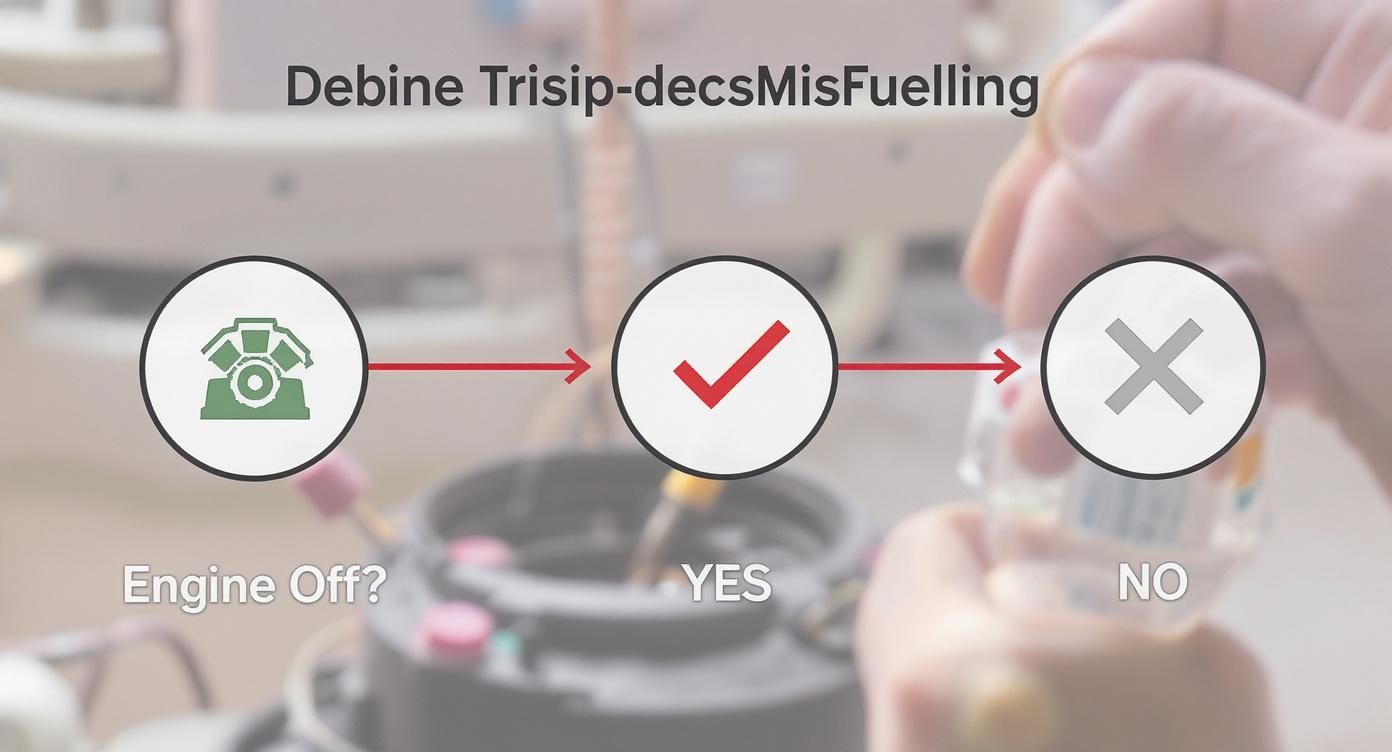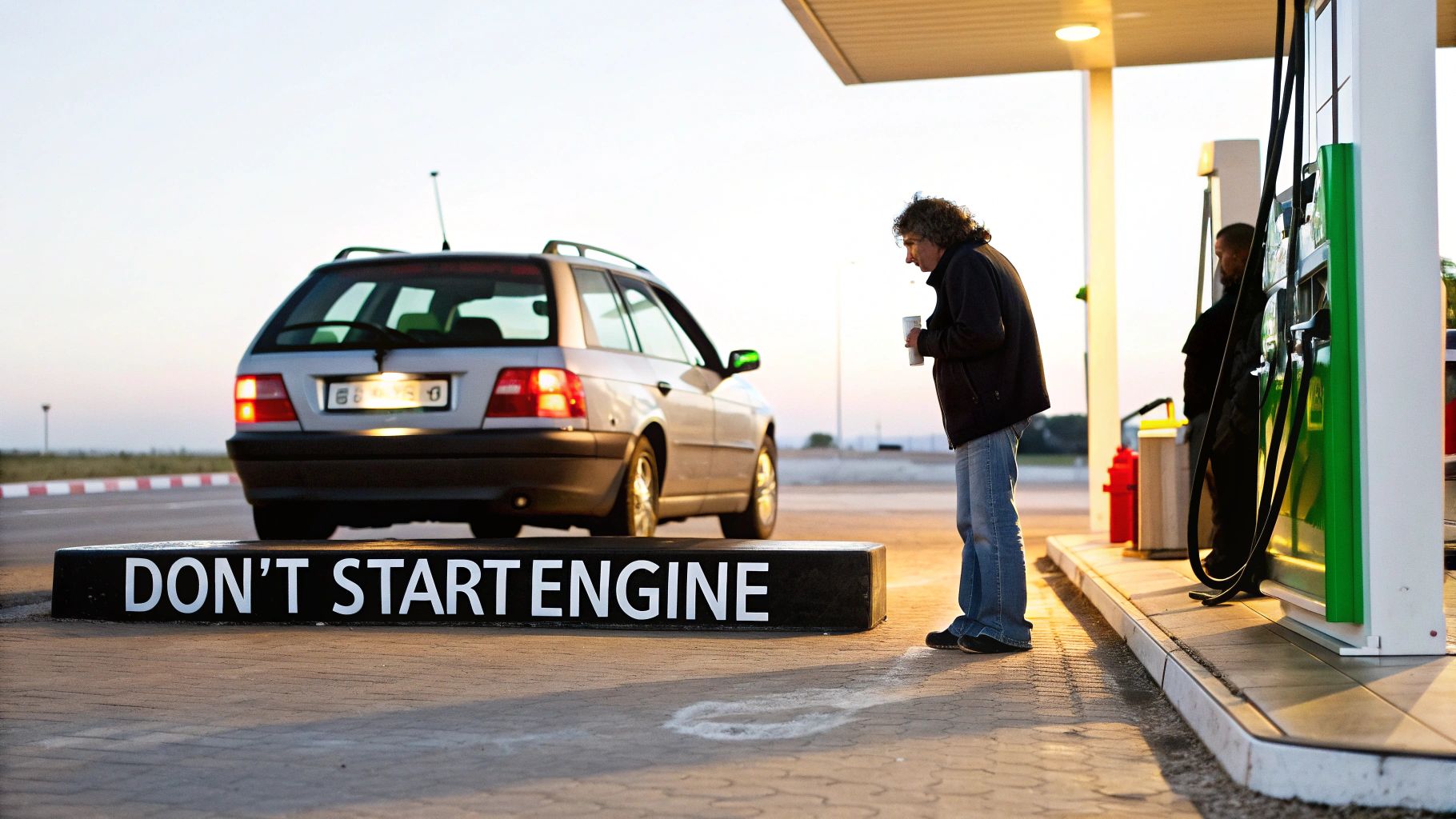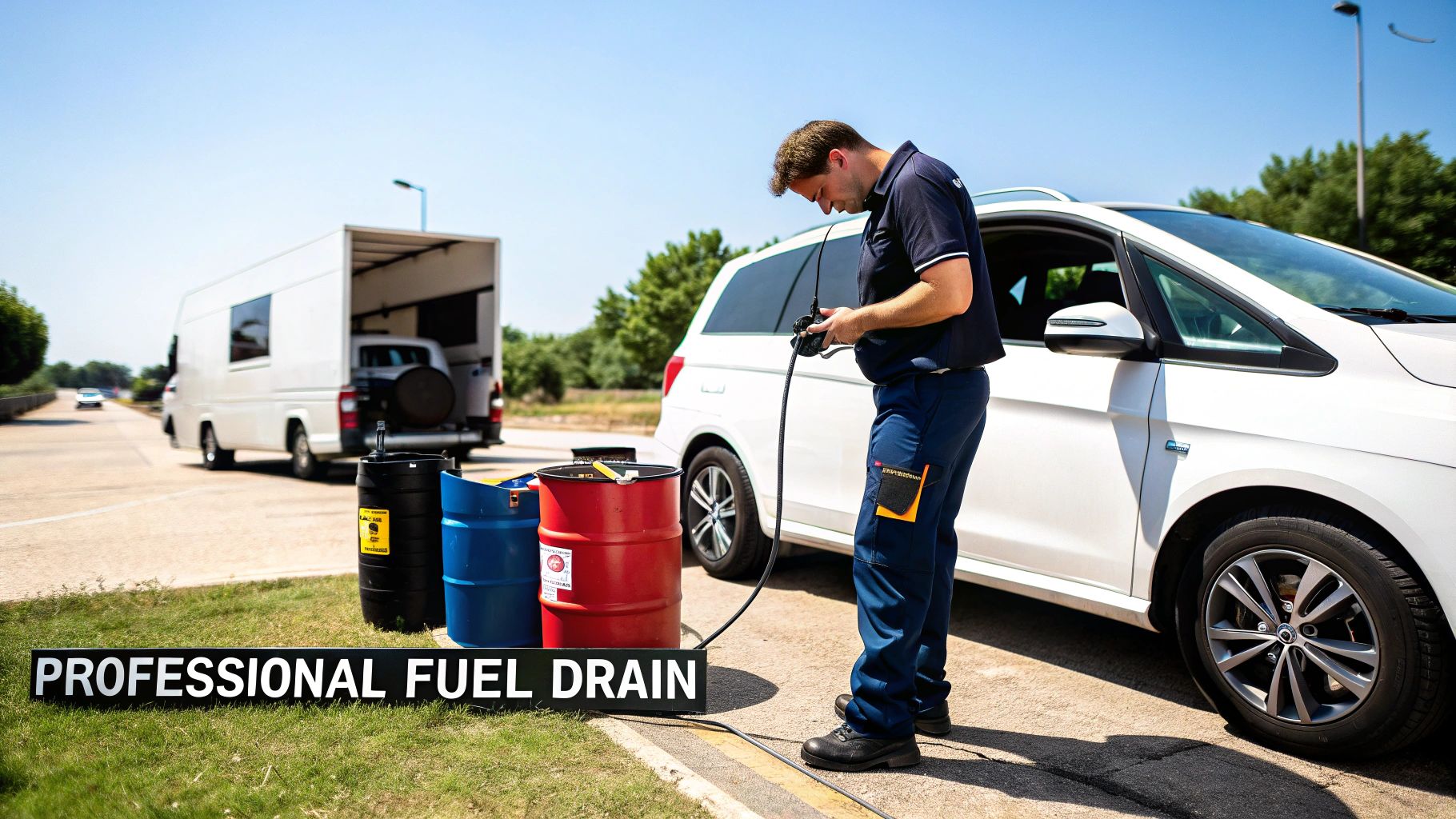20 litres of petrol in diesel car: What to Do Next
- Misfuelled Car Fixer

- 2 days ago
- 11 min read
It’s a heart-sinking moment every driver dreads: you’ve just put 20 litres of petrol into your diesel car. It’s a serious mistake, but it's absolutely fixable. The golden rule, the one thing that will save you a world of pain and expense, is simple: do not start the engine. Don’t even turn the key to the 'on' position.
Keeping the engine off is your best defence. It stops the petrol from being pulled into the fuel system, effectively containing the problem in the tank. This single action is the difference between a simple fix and a wallet-emptying repair bill.
Your First Five Minutes After Misfuelling
That sudden realisation at the pump can send anyone into a panic. But before you do anything else, take a breath. What you do in these first few minutes is critical and will dictate how smoothly (and cheaply) this gets sorted.
Again, I can't stress this enough: leave the engine completely off. Don't be tempted to turn the key to close a window or check the radio. Modern cars often prime the fuel pump the second the ignition is switched on, and that's enough to start sending the damaging petrol towards your engine.
Secure Your Vehicle and Get Help
Your immediate priority is safety. Leave the car exactly where it is, by the pump. Pop the handbrake on and, if you can, put the car in neutral—this will make life much easier when it needs to be moved.
Once the car is secure, walk into the petrol station and let the staff know what's happened. Trust me, they've seen this countless times before and will know what to do. They’ll usually put some cones around your car to keep other drivers away, giving you the time and space you need to sort things out. Knowing where to find reliable roadside help is key in situations like this.
Next, you need to call a mobile fuel drain specialist. To get the fastest service, have this information ready:
Your precise location (the name and address of the petrol station).
Your vehicle’s make, model, and registration number.
Roughly how much fuel you put in (e.g., "about 20 litres of petrol").
Most importantly, confirm that you have not started the engine.
To help you remember what to do in the heat of the moment, here's a quick checklist.
Immediate Misfuelling Checklist
Following these steps ensures you're doing everything right while waiting for the experts to arrive.
This infographic really drives home the importance of that one crucial decision.

As you can see, leaving the engine off puts you on the green path—a straightforward and much less expensive fix.
By not starting the engine, you contain the problem to the fuel tank. This turns a potential engine-destroying disaster, costing thousands, into a simple drain-and-flush procedure that a mobile technician can complete on-site.
Understanding what happens when you put petrol in a diesel car helps clarify why these initial steps are so vital. Following this plan from the get-go protects both your engine and your bank balance.
How Petrol Destroys a Diesel Engine

To really get your head around why putting even 20 litres of petrol in a diesel car is such a massive problem, you need to understand one key thing. It's not just about how the fuels burn; it's about their fundamental nature.
Diesel fuel is oily. It has a greasy, viscous feel to it, and that’s not an accident – it’s a crucial design feature. This oiliness lubricates all the high-precision parts in your fuel system, keeping them running smoothly under mind-boggling pressure.
Petrol is the polar opposite. It’s a solvent. Think of it like a degreaser. When it gets into a diesel system, it immediately starts washing away that vital lubricating film from every single component it touches. And that’s where the trouble really begins.
The Destructive Domino Effect
The first part to suffer is almost always the high-pressure fuel pump. This bit of kit is a true engineering marvel, built to incredibly fine tolerances. It absolutely depends on the lubrication from diesel fuel to stop its metal components from grinding themselves to pieces.
When petrol is introduced, that lubrication vanishes. Friction goes through the roof, generating immense heat and causing metal to shear off metal. This creates tiny metallic particles – what we in the trade call "swarf."
This cloud of microscopic metal filings is then blasted through the rest of the fuel system under immense pressure. It travels down the fuel lines, straight into the injectors. These injectors have tiny nozzles designed to spray a perfect, atomised mist of fuel, but the swarf clogs them and carves up their internal surfaces, ruining them completely.
It all happens frighteningly quickly. Running the engine for just a few moments with the wrong fuel mix can be enough to condemn the entire system, from the pump right through to the injectors.
The Financial Fallout
As you can imagine, this sort of mechanical damage doesn't come cheap. For UK drivers, the cost of putting petrol in a diesel can be eye-watering, typically ranging from £500 to over £2,000. The final bill depends on whether a simple fuel drain and flush catches the problem in time, or if key components are already destroyed and need replacing.
This is why a simple mistake at the forecourt can so easily turn into a four-figure repair bill.
The real enemy here isn't just the wrong fuel type; it's the total loss of lubrication. Petrol basically acts like sandpaper inside the delicate, finely-tuned clockwork of your fuel system. This is why getting a professional out is non-negotiable—it's about preventing a catastrophic and expensive failure.
A professional fuel drain isn't just about siphoning out the contaminated fuel. It’s a meticulous process to flush every last trace of petrol and those damaging metal particles out of the system. If you're interested in the science behind it all, you can learn more by reading our guide on the difference between petrol and diesel fuel.
What Happens if You've Already Driven the Car?
Sometimes, the horrible realisation doesn't hit you at the pump. You might drive off, perhaps for a mile or two, before noticing something is seriously wrong with how the car is behaving. If this is you, knowing the warning signs is your best bet for preventing a costly repair bill.
At first, everything might seem fine. That’s because your engine is still running on the bit of diesel left in the fuel lines and filter. But once that petrol-diesel mix starts to work its way through, the symptoms are usually sudden and pretty hard to ignore.
The First Tell-Tale Signs: Power Loss and Strange Noises
One of the first things you'll almost certainly notice is a major drop in power. You'll put your foot down, but the car will feel weak and sluggish, as if it's struggling to pull itself along. This is the petrol messing with the diesel engine's combustion cycle.
You'll probably also hear a very distinct, and frankly worrying, knocking sound from the engine. It's often described as a 'pinking' or rattling noise. This is the sound of the petrol igniting at the wrong moment inside the engine, which puts a huge amount of stress on its internal parts.
As soon as you feel the power go or hear that knocking sound, your only job is to pull over as safely and quickly as possible. Switch the engine off immediately. The longer it runs, the worse the damage gets.
Trying to push on for even another half a mile could be the difference between a simple fuel drain and a bill for thousands of pounds to replace the entire fuel system.
Alarming Smoke and Trouble Starting
Another dead giveaway is the exhaust. You might see a lot of white or even bluish smoke pouring out of the back. This is a classic sign of unburnt fuel and oil being forced through the system – a clear signal that the engine's combustion process is completely out of whack.
If the engine stalls, you'll have a tough time getting it started again, if it starts at all. By this point, the petrol will have stripped away the lubricating properties of the diesel fuel, which is vital for protecting the high-pressure fuel pump and injectors.
Keep an eye out for these common symptoms:
Engine Misfiring: The car might feel jerky or like it’s hesitating when you try to accelerate.
Warning Lights: The engine management light on your dashboard will almost definitely light up.
Stalling: The engine could just cut out, especially when you're stopped at a junction or driving slowly.
If you experience any of this right after filling up, don’t ignore it. Pull over, turn off the engine, and call for a fuel drain specialist. Catching it early is the single most important thing you can do to save your car from serious damage.
What a Professional Fuel Drain Involves

Seeing the fuel drain technician pull up is often a massive relief. But what do they actually do? It helps to know what’s happening, so let’s walk through the process. It’s a lot more involved than just siphoning out the bad fuel; it's a careful, methodical procedure to get every last drop of the contaminated mix out and keep your engine safe.
First things first, the technician will make the area safe. This means setting up cones, checking the handbrake is on, and making sure there are no ignition sources nearby. They'll then need to access your fuel tank directly, which is often done through the filler neck or sometimes by lifting the back seats to get to the fuel sender unit. This is the only way to guarantee a complete drain.
Getting The Contaminated Fuel Out
Using specialist pumps, the technician will start to remove the entire contents of your fuel tank. This equipment is Atex-approved, which is the industry standard for safely handling flammable liquids like petrol. It's a powerful and controlled extraction process that sucks out the 20 litres of petrol in your diesel car along with all the diesel it's mixed with.
But the job isn’t finished once the tank is empty. Petrol will have already made its way into the fuel lines and filter. The technician will then flush this part of the system with clean, fresh diesel. This is a non-negotiable step to clear out any residual petrol that could cause serious damage the moment you turn the key.
A proper, professional service never just "tops up" the tank and hopes for the best. They meticulously flush the entire low-pressure side of the fuel system to ensure no damaging petrol remains to harm the sensitive high-pressure pump and injectors.
Final Checks And Getting You Started
With the system now completely clean, the technician will add around 5 to 10 litres of the correct diesel back into your tank—more than enough to get you safely to the next petrol station. They’ll often add a special lubricant additive too. This is great for restoring the oily, protective film that diesel provides and which petrol strips away, giving your fuel pump some extra protection on that first start.
Now for the moment of truth. They'll prime the system to get the clean fuel flowing through, then start the engine. A good technician will be listening intently for any odd sounds and checking the dashboard for warning lights. In almost every case where the engine wasn't started with the wrong fuel, the car will fire up and run smoothly.
It's a detailed job for a reason. If you're wondering about the pitfalls of a DIY approach, our guide on the safe way to drain a fuel tank explains why professional gear and know-how are so essential. From arrival to departure, the whole process usually takes between 45 and 90 minutes, getting you back on your way with minimal drama.
The Broader Impact of Misfuelling a Diesel Engine

Aside from the immediate stress of putting 20 litres of petrol in your diesel car, it's worth taking a moment to think about the bigger picture. Running a diesel in the UK today means being mindful of its environmental footprint, and a misfuel only goes to show how easily things can go wrong.
Diesel engines have been in the spotlight for a long time now, mostly because of what comes out of the exhaust pipe. They naturally produce more nitrogen oxides (NOx) and fine particulate matter – that black soot you sometimes see – than petrol engines. These are the pollutants that cause real problems for air quality in our towns and cities, contributing to serious respiratory issues.
It's for this very reason that modern diesels are packed with clever technology. Systems like Diesel Particulate Filters (DPFs) and Selective Catalytic Reduction (SCR) are there specifically to trap and neutralise these harmful emissions before they can escape.
How Misfuelling Makes Emissions So Much Worse
When you introduce petrol into the mix, a diesel engine can no longer burn its fuel cleanly and efficiently. The resulting combustion is incomplete, which causes a huge jump in harmful emissions. You'll see far more black smoke pouring out, and the delicate emissions control systems become completely overwhelmed.
It’s no surprise, then, that a car driven on the wrong fuel will fail an MOT emissions test, hands down. Seeing it from this angle helps to understand why the standards are so strict. An engine damaged by petrol isn't just a headache for your wallet; it's a problem for the environment, too.
The health damages linked to diesel vehicle pollution in the UK are estimated at a staggering £6 billion annually. The health costs from diesel emissions are considered to be at least five times higher than those from petrol vehicles. You can explore more on the health impact of vehicle emissions.
This enormous cost to public health is a direct result of the nitrogen oxides and particulates that damage our lungs. Keeping your diesel running as it should isn't just about performance or reliability – it’s about doing your bit for the air we all share. A misfuelling incident, if not sorted properly, cuts right to the heart of that responsibility.
Common Questions After Putting Petrol in a Diesel Car
That sinking feeling at the pump is often followed by a flood of questions. It's a surprisingly common and stressful mistake, but getting straight answers can help you figure out what to do next. We hear these questions all the time from drivers in your exact situation.
Is It Really That Bad if It Was Only a Small Amount of Petrol?
Yes, unfortunately, it is. While dumping 20 litres of petrol in a diesel car is a major mix-up, even a few litres can kickstart some serious problems. Think of petrol as a solvent – it immediately starts to strip away the oily, lubricating properties of diesel fuel.
Your diesel engine’s fuel pump and injectors rely on that lubrication to function without grinding themselves to bits. It doesn't take much; even a 5% contamination of petrol in your diesel tank is enough to cause damage. The simple truth is there's no "safe" amount of the wrong fuel. It always needs to be sorted out by a professional.
Will My Car Insurance Cover the Fuel Drain?
That’s a big "it depends." Many standard car insurance policies won't cover misfuelling because it's typically classed as driver error, not an accident. However, some fully comprehensive policies or special add-ons might offer cover.
Your best bet is to dig out your policy documents or give your insurer a quick call to check. But before you make a claim, do the maths. A professional mobile fuel drain often costs less than your insurance excess, and paying for it directly means you protect your no-claims bonus.
Why Can't I Just Siphon It Out Myself?
In the age of YouTube tutorials for everything, trying a DIY fix can seem tempting. Please don't. Attempting to drain the fuel yourself is a genuinely terrible idea for a few critical reasons:
Fire Risk: Petrol is incredibly flammable, and its fumes are explosive. One tiny spark from static electricity or a metal tool hitting the tank could be catastrophic. It’s just not worth the risk.
You'll Never Get It All: A simple tube can't reach every last drop. You'll inevitably leave a toxic cocktail of petrol and diesel in the fuel lines, filter, and the bottom of the tank, ready to be sucked into your engine the moment you turn the key.
Environmental Hazard: What do you do with 50 litres of contaminated fuel? You are legally on the hook for disposing of it safely. Pouring it down a drain is illegal, environmentally damaging, and carries heavy fines.
Professionals use specialised, Atex-certified pumps designed for flammable liquids and are licensed to transport and dispose of contaminated fuel correctly. This is one of those jobs you really should leave to the experts. Given how common diesel cars have been in the UK, understanding their specific needs is vital. You can learn more about the historical context of diesel vehicles in Europe to see why fuel compatibility is so critical for both engine performance and emissions.
If you've put the wrong fuel in your car in Suffolk or anywhere else in the UK, stay calm and, most importantly, don't start the engine. Call the experts at Misfuelled Car Fixer for immediate, 24/7 help. Our mobile technicians will come to you and get you safely back on your journey. Visit us at https://www.misfuelledcarfixer-suffolk.co.uk.



Comments